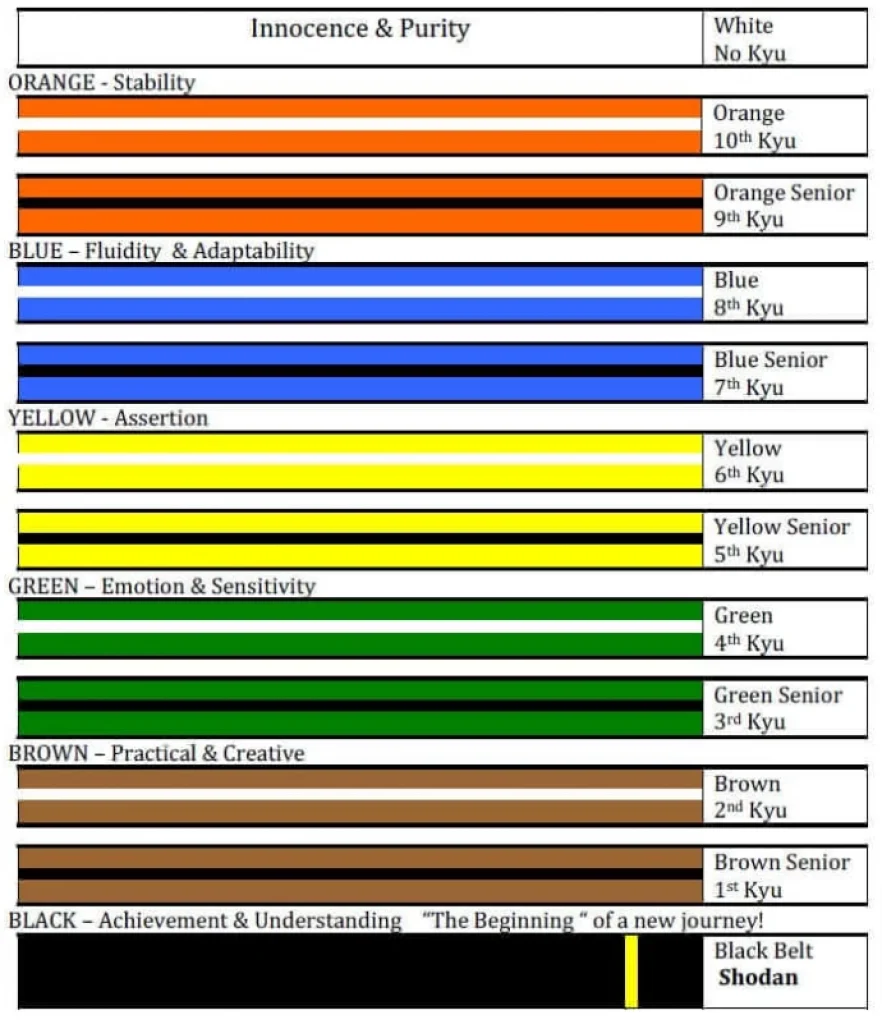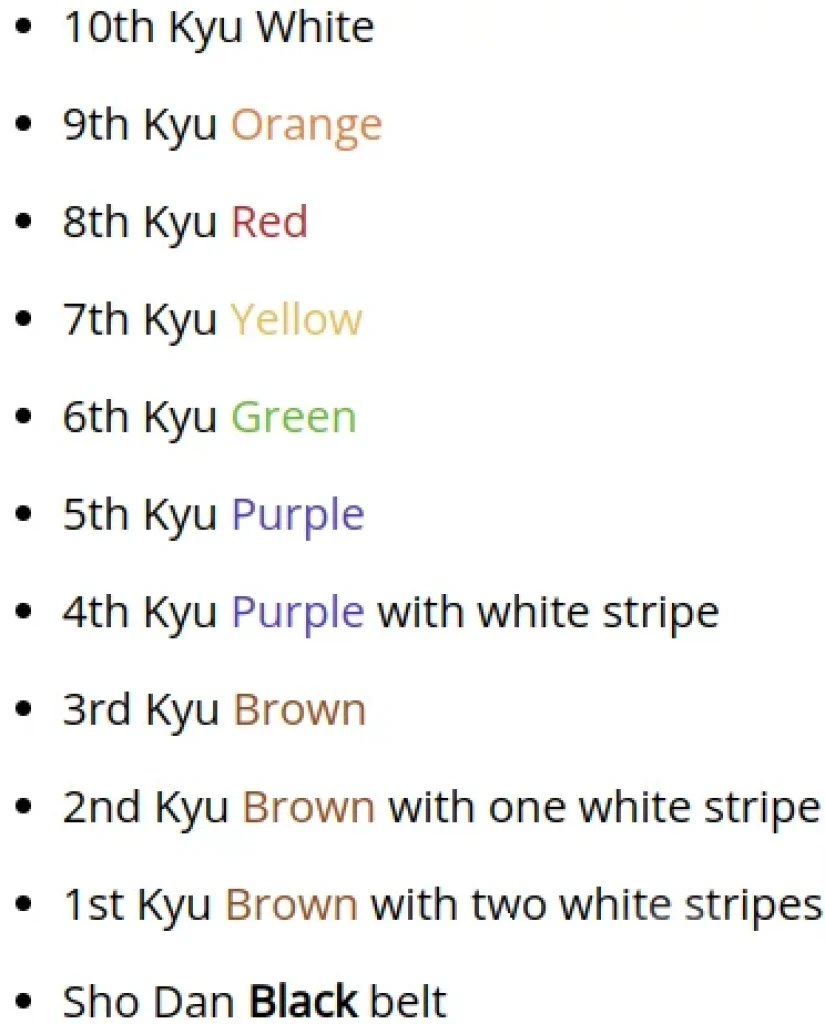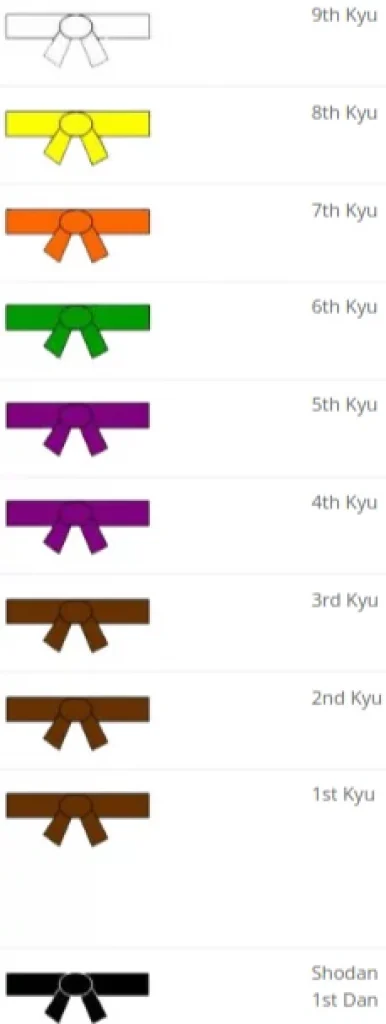We Explain here the Order of Karate Junior Belts [aka Kids Belt Ranking]
Before we dive in to explain the order of karate junior belts, we offer to go through a small survey. As martial arts coaches and enthusiasts, we are eager to be updated on trends and moods around the martial arts.
Later, when we have enough data/answers to make from it a statistics outcome, we will share the results here – on BJJaccessories and our social media. Stay tuned and thank you for sharing!
And now, let’s dive in!
How Does Belt Grading Work in Karate?
Students start their journey with a blank white belt. With time, while training, they progress and undergo regular evaluations – usually called promotions – to determine their readiness for the next level.
These promotions often include demonstrating specific techniques, forms (katas), and sparring. By successfully passing each test, students earn the next belt color.
Karate Belts in Order and their meaning:
While the exact interpretation can vary between different styles and schools, here is a general overview of the most commonly recognized belt colors:
| 1. White Belt: | The starting point for all karate students |
| 2. Yellow Belt | indicates a basic understanding of fundamental techniques |
| 3. Orange Belt | students gain confidence and build upon their foundation |
| 4. Green Belt | green belt is awarded to students who have developed a solid understanding of fundamental techniques |
| 5. Blue Belt | represents the expanding horizons and increasing knowledge of karate |
| 6. Purple Belt | A color often associated with royalty, the purple belt indicates a deeper level of understanding and commitment to the martial art |
| 7. Red Belt | signifies an advanced level of skill and expertise and a significant milestone in a practitioner’s journey toward the coveted black belt |
| 8. Brown Belt | Demonstrating proficiency and nearing mastery, the brown belt signifies maturity and impending black belt attainment |
| 9. Black Belt | black belt represents mastery of the fundamentals and a commitment to continuous growth |
It’s important to note that within each belt color, there may be additional ranks or degrees to further recognize a student’s progress and expertise.
This is a particularly common practice in kids’ karate belt order. That is why you may see kids’ karate belts have different colors than the karate belt order in the adult ranking system.
Kids karate belts in one of the Kyokushin karate dojos

Junior Karate Belts
The number of belts in junior karate can vary depending on the specific style and school.
However, a common progression includes the aforementioned white, yellow, orange, green, blue, purple, and brown belts.
In some cases, schools may introduce some additional colors (such as red belts) and exclude some others, or have intermediary belts or stripes within these colors to provide additional milestones for young practitioners.
Youth karate belt order in different karate schools

It is advisable to consult with the instructor or the specific karate school for accurate information regarding their belt system.
Is There a Junior Black Belt in Karate?
Yes, there is a junior black belt in karate. The junior black belt is a milestone for young karateka who have demonstrated exceptional skill, dedication, and discipline in their karate practice.
While the requirements for achieving a junior black belt can vary, it generally involves an extensive knowledge of techniques, forms, sparring, and a deep understanding of the principles of karate.

Attaining a junior black belt serves as a stepping stone toward the ultimate goal of a full black belt.
What Is the Difference Between a Junior Black Belt and an Adult Black Belt?
The difference between a junior black belt and a black belt lies primarily in the level of experience and maturity.
A junior black belt is typically awarded to young practitioners who have displayed exceptional skill and dedication at a relatively early stage of their martial arts journey.
How Long Does It Take to Get a Jr Black Belt?
The time it takes to earn a junior black belt can vary depending on several factors, including the frequency of training, the individual’s commitment, and the specific requirements set by the karate school.
For instance, according to some karate belt requirements, from the age of 12, children have the opportunity to undergo their Shodan grading, which marks their entry into the first level of black belt. This initial achievement is recognized as a cadet grade, transitioning into an adult grade once they reach 15 years of age. Starting at the age of 12, these aspiring Shodans can participate in the junior black belt program, a specialized pathway designed to support their journey towards becoming accomplished martial artists.
What Is the Youngest Age You Can Get a Black Belt in Karate?
The youngest age to attain a black belt in karate can vary among different schools and styles.
While some schools may have minimum age requirements for black belt testing, it is generally uncommon for very young children to achieve this prestigious rank.
What is a junior black belt in karate
FAQ
Is a Green Belt Better Than Black?
The color of a karate belt does not necessarily indicate one’s overall skill or ability in martial arts.
Each belt color represents a specific level of progression and mastery within the particular style and system. While a black belt signifies a high level of proficiency and knowledge, a green belt is an important milestone on the path towards mastery.
Comparing a green belt to a black belt is like comparing two different stages of development. Each belt color holds its own significance and contributes to an individual’s growth and journey in karate.
What Is a Junior Yellow Belt?
A junior yellow belt is a rank awarded to young karate practitioners who have shown dedication, discipline, and progress in their training.
It usually follows the white belt and represents the first step towards growth and development in karate.
Junior Karate Belt Order in UK
In the United Kingdom, the junior karate belt order generally follows a similar progression as in other countries.
The belt colors and ranks may align with the international standards established by recognized karate organizations and governing bodies.
However, it’s worth noting that some schools and associations may have specific variations or modifications to suit their curriculum.
To obtain accurate information on the junior karate belt order in the UK, it is advisable to consult with local karate schools, instructors, or national karate associations.
Here is one of the karate grading systems for children in England:
How many karate belts are there for kids in UK?
- 9th Grade – Red Belt
- 8th Mon and then 8th Kyu – Yellow Stripe/Yellow Belt
- 7th Mon and then 7th Kyu – Orange Stripe/Orange Belt
- 6th Mon and then 6th Kyu – Green Stripe/Green Belt
- 5th Mon and then 5th Kyu – Blue Stripe/Blue Belt
- 4th Mon and then 4th Kyu – Purple Stripe/Purple Belt
- 3rd Mon and then 3rd Kyu – Brown Stripe/Brown Belt
- 2nd Mon and then 2nd Kyu – Brown Belt
- 1st Mon and then 1st Kyu – Brown belt with Black Stripe Belt
- 1st Dan (Junior) – Black Belt
Shotokan Karate Junior Belts
Shotokan Karate, one of the most widely practiced karate styles, follows a belt system that encompasses both junior and adult practitioners.
The junior belt order in Shotokan Karate typically includes white, yellow, orange, green, blue, purple, and brown belts.
Shotokan Karate places a strong emphasis on discipline, technical precision, and the development of strong stances and strikes.
Here are Shotokan karate belt color levels in order by three different schools:
How many belts are there in karate for kids in Shotokan


